Ben Greenfield in Tokyo #2
DAY2
I am spending days with Ben Greenfield in my hometown Tokyo Japan. Since he had a private speaking event yesterday, I visited my old neighbor, Musashikoyama, Shinagawa, Tokyo where I had been living there until 7th grade. My elementray friends came to see me and I met most of them for the first time in two decades!! It made me so nostargic and reminded me of childhood. and…Guess what!? My random visit because of Ben was a sheer chance to come back to the september festival in my old hometown. It had been 20 years since I participated in last time. What a huge surprise! Sunday was the day for me!
My old friends recomended me taking Ben to their hometown festival, but I was afraid of suggesting “too local“ experience. However, Ben is not a regular turist, but a true experience seeker,. Ben was like…”I’m game, lets do it!!”, so I told me friends we were coming. They prepared our outfits and permission from neiborhood association because it is very traditional and only for the residents
Yakumo is the most well known places for wantanmen in Tokyo.
Before we visited my old neighbor, we punished a bowl of amazing ramen in Tokyo. Yakumo has one Michelin star and is located about ½ miles from Shibuya, one of the most popular districts for shopping in Tokyo. It’s been one of the most popular Ramen restaurants for many years. The tasty broth and the volume of Prawn and Pork wontons will keep your tummy full for hours. The ramen in this place does not make you feel bloated. The soup is super clear and taste like it's from fish and salt based soup. I and Ben took Kion Lean and Gluten Guardian for guilt free ramen experience.
order by vending machine
This ramen place is my “go to“ place when come back to Japan. Ramen place has Michelin star? This Japanese confort food is an extremely boom all over the place on the planet in my opinion. I love to see many people enjoy ramen, and Ben is one of them. He asked me for a good ramen place. I know he is a foodie as well as particular about what he puts in his body. Yakumo makes everything from scratch and has a Michelin star, so I took hime there. What makes this experience very special for Ben? Because there is absolutely no English and no pictures in this place, and orders are taken by vending machine in Japanese. Well, this place is not foreigner friendly place at all. Since I translated everything for him, Ben had a great bowl of ramen with extra topping after we waited for about 30 minutes at line (very busy during lunch time) Dish recommended by the supreme ramen maniac, AKA, my brother was Shirodashi (meaning “white broth”) wanton ramen. Ben had a white broth ramen and I had a black broth ramen (picture above) We enjoyed tasting both!
Ben and Tateki at Yakumo
Types of Festival
There are so many traditional festivals held annually all across Japan, each one usually associated with a shrine or a temple, and organized by the local community. Portable shrines (mikoshi), floats, food stalls, and games are just some of the common features you can find.
Matsuri is the Japanese word for festival. Japanese festivals are not held on specific dates throughout Japan. Each neighborhood schedules and holds their own matsuri. A Japanese festival is usually held anywhere from late spring to fall, and it is possible to attend several throughout the year. There are many large and famous matsuri. The larger festivals are usually visitor-friendly, but you should go with a Japanese friend in order to get the full experience. When I was a kid, an uniform was provided when carring “mikoshi“. However, adults, who are resident in the area must be recognized by neighbor associate to have an official uniform.
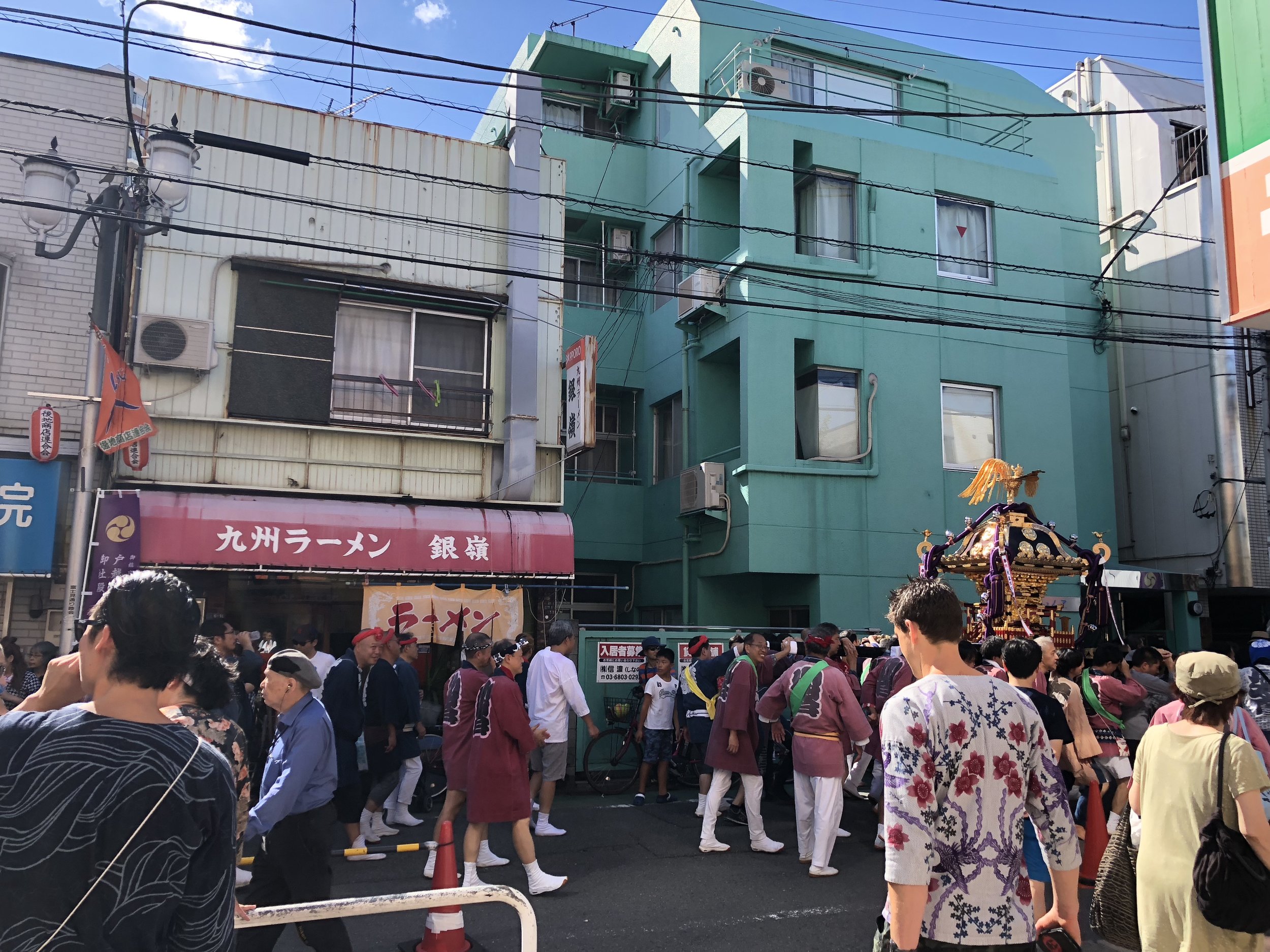


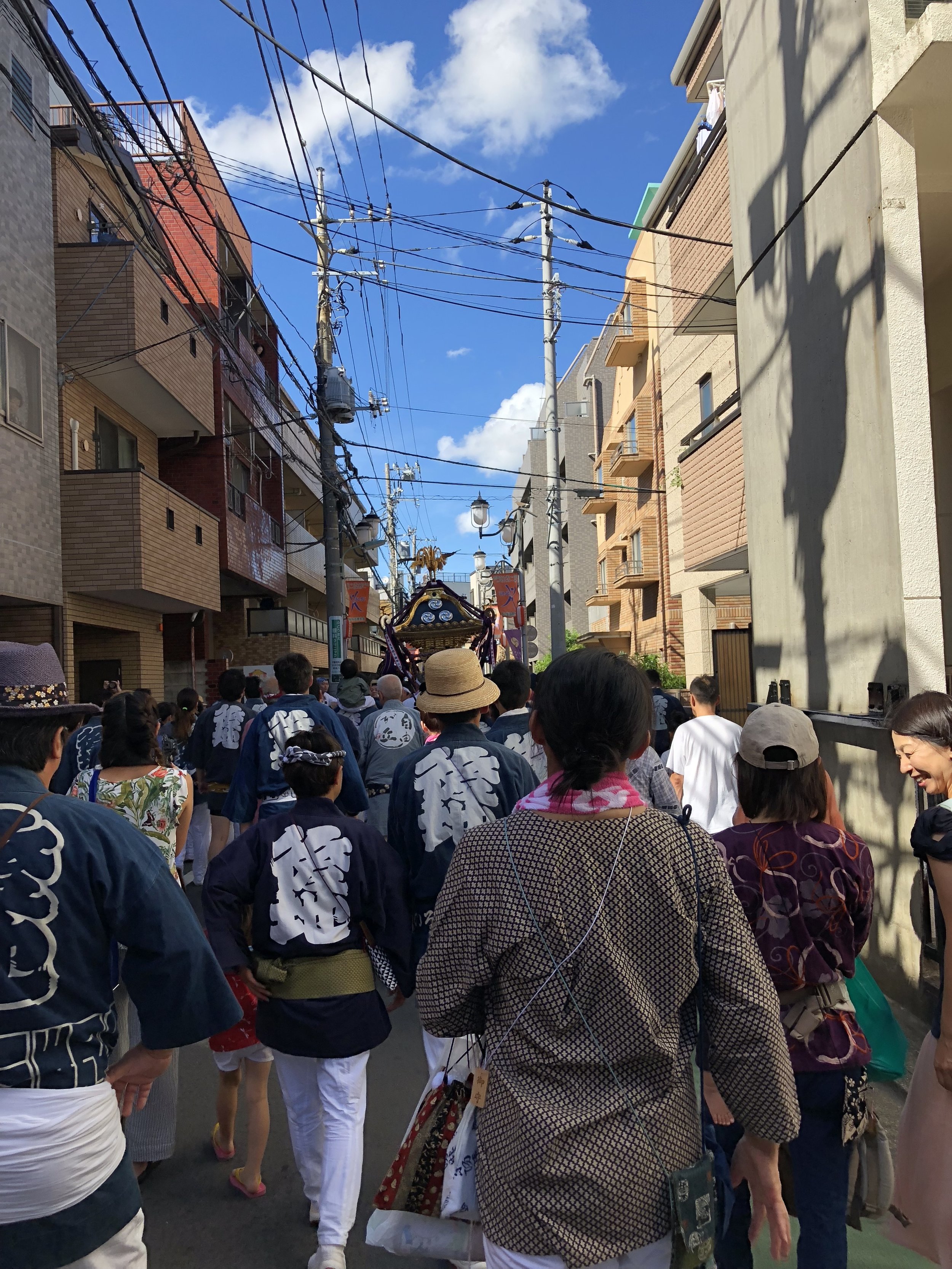
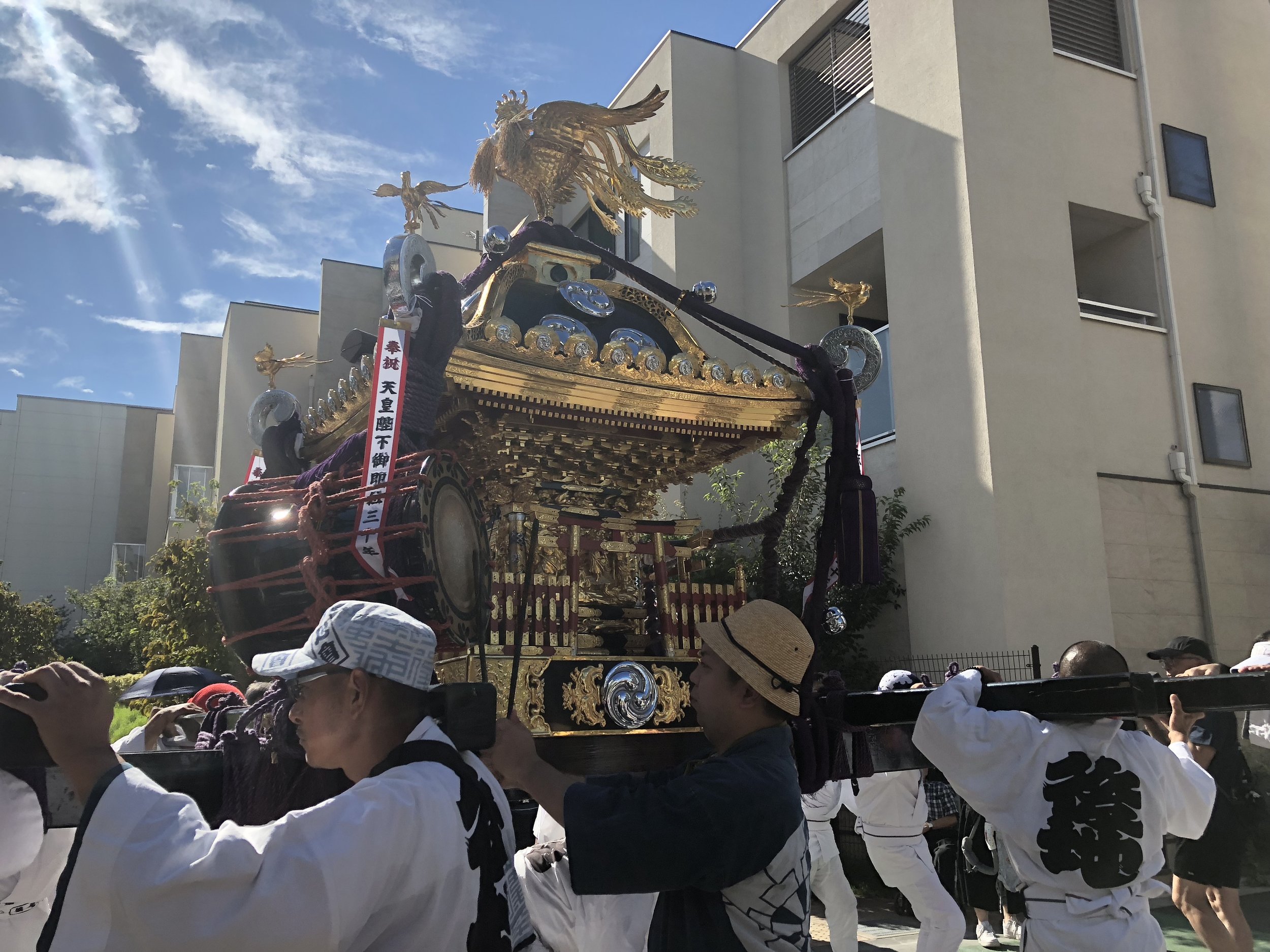
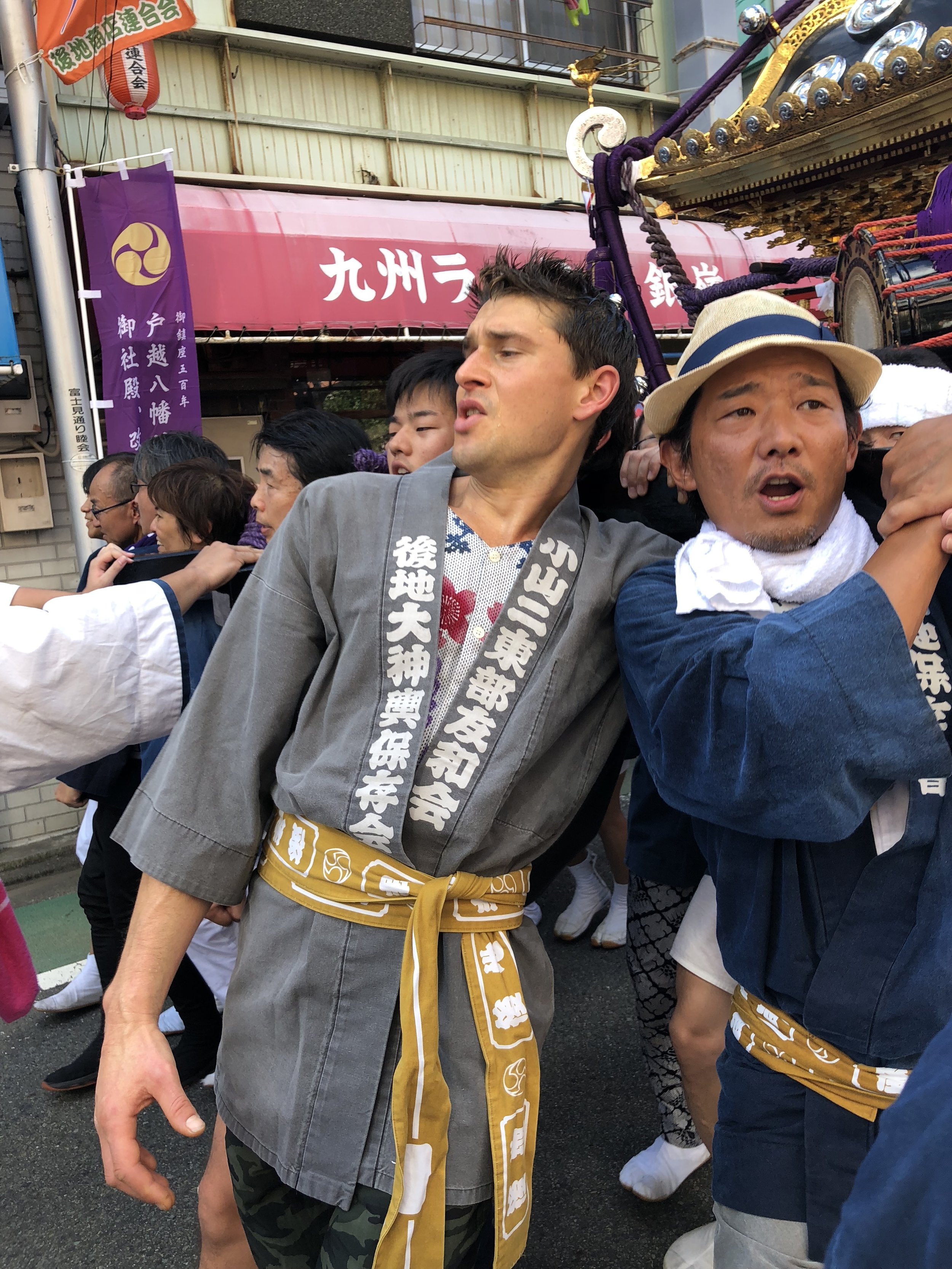
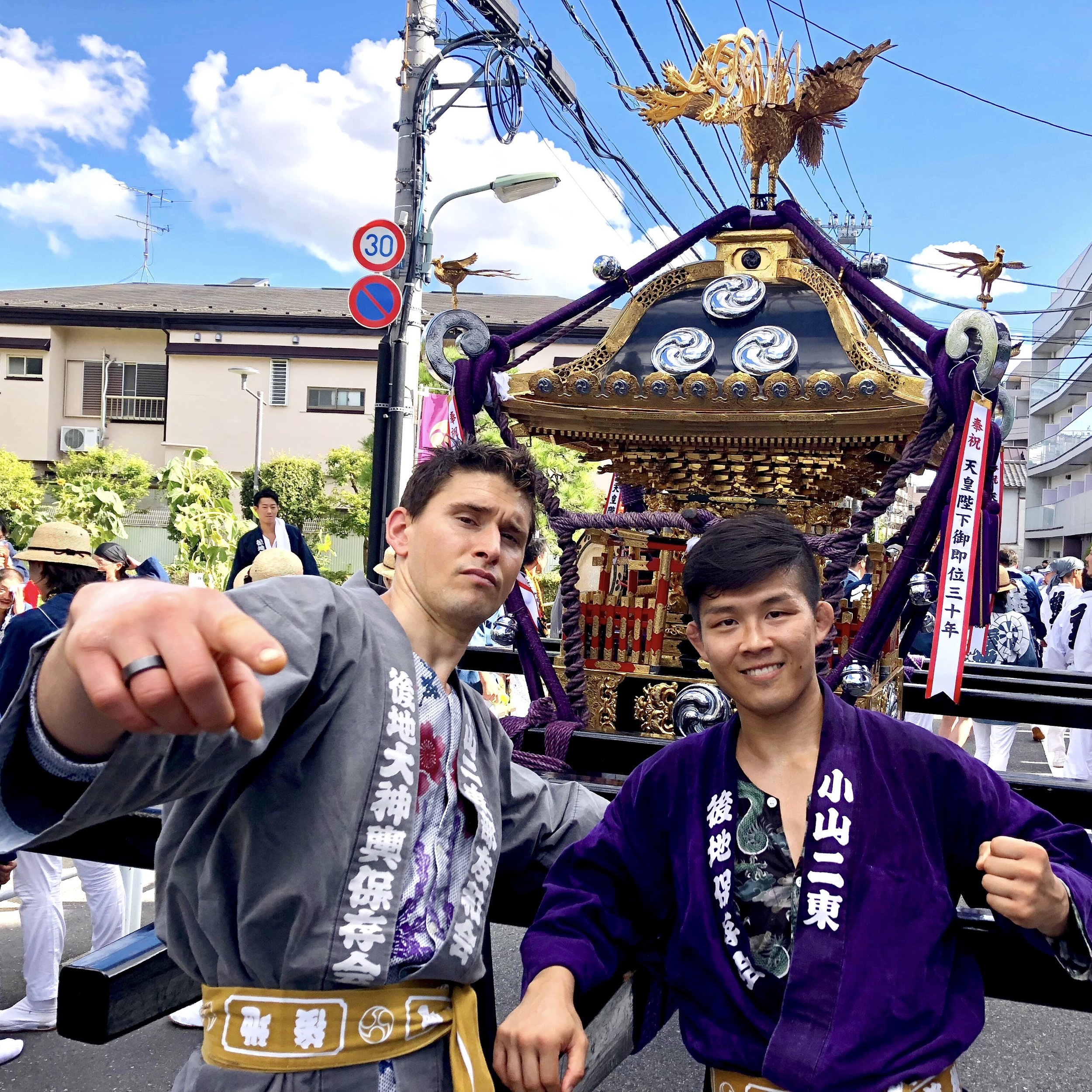
“Shinto Jinjya” are the center of the Japanese festival. During the festival, mikoshi (portable Shinto shrines that look like miniature temples) are carried throughout the neighborhood. Shrines house the kami (gods or spirits) for the duration of the festival, and the locals celebrate matsuri by carrying the shrines through the streets, drumming and chanting and bouncing the whole way.
What we did was ”mikoshitogyo” carrying of miniature shrine, where the guardian god/sprit of my hometown stays in. We were carrying the regional guardian god to bless local residents. The shrine is huge and very heavy, and they require a dozen or more people to carry. Especially, Ben is taller than other Japanese people, so he had to carry hard or keep bending his knee all the time.
Traditional festival in my old hometown
What to expect
Most matsuri are rather casual affairs, but some mikoshi carrying or festivals have significant religious significance and are not to be touched by outsiders. I even felt like I was afraid of jumping in when old people were carrying mikoshi next to me, but they welcomed me and Ben very well.
Heavy & Tradition
My old hometown has a very traiditonal way to carry the shrine. We had to lean toward the center, so if there is no power balance from each angle, some people get pushed by the shrine and kicked out from the very narrow road in Tokyo. You know how tight it i in concrete jungle. There are some guys guiding carriers to stay on the middle of the road.
Wahsshoi
I have no idea why we yell “washoi“ while carring the shrine. It is the most well-known festival chant in Japan. According to this page, the origin of the wasshoi chant is said to be a Japanese phrase meaning “Carry Peace” or “Carry a Ring”; “wa” in “wa-sshoi” can mean both “peace” and “ring.” The former expresses people’s wish for peaceful lives while the latter symbolizes the unity required to achieve something collectively as a team.
Origins
Mikoshi parades have their origins in religion, and the parade does start from and finish in the shintô sanctuary. Shintô is Japan’s indigenous religion; it has strong links with animism, which has a strong respect for the divine forces of nature and the rhythm of seasons and agriculture. Shintô is therefore related to the primal energies of life and Earth. Matsuri are moments of religious expression; but more than that, they are moments when Japanese people make peace with their inner energy.
I was expecting that it would be very difficult to join into a group of mikoshi careers who will be carrying the shrine around my old hometown for the festival because it is quite an unusual for a gaijin (foreigners), particularly for one who doesn’t belong to the community. I saw another foreigner joined the group, although he speaks Japanese and has been living in Musashikoyama for years and fully belongs to the mikoshi careers group association. Fortunately, one of my close friends dad is a board member, so we got traditional uniforms provided and permission to join the team. I am thankful, as the experience is not only completely new to Ben and threw back me to 20 years ago, but just very unexpected.
Shimizu-yu (hot spring in Tokyo)
Hot Spring
Natural hot springs (Onsen) are numerous and highly popular across Japan. Every region of the country has its share of hot springs and resort towns, which come with them.
There are many types of hot springs, distinguished by the minerals dissolved in the water. Different minerals provide different health benefits, and all hot springs are supposed to have a relaxing effect on your body and mind. Hot spring baths come in many varieties, indoors and outdoors, gender separated and mixed, developed and undeveloped.
Black water hot spring ©www.shimizuyu.com
I and Ben went to Shimizu-yu right after carrying Mikoshi, and we did hot and cold therapy there. The natural hot spring and the hot rock sauna are really famous in Japan. Shimizu-yu Musashi-Koyama is popular because you can take a natural hot spring bath at a reasonable price in Tokyo. I know many of you from oversea may think “how come we find hot spring in the middle of concreate jungle?“ Well, this place has “history“! They found the hot spring from underground and it was established in 1924. The Kuroyu (black water hot spring) comes from 200 meters below ground, and said to promote skin softening and moisturizing. We enjoyed an electric bath, Jacuzzi and also a jet bath. All of them have the device to create nanobubble, so can have a Kuroyu nano bubble bath. 100 years old history and modern technologies meet up right here!
The Golden Hot Spring outdoor style at Shimizuyu ©www.shimizuyu.com
This brownish-yellow hot water, which contains water at 38 degrees Celsius brought up from 1500 meters below. This hot water is good at moisturizing, and it is called ‘Hot spring of beauties’ or ‘Hot spring for beautiful skin’. It was great recovery and relaxing because this Golden water is qualified as a medical treatment spring that contains abundant amount of iodine, which helps to cure external wounds. The Golden Hot Spring and Black Hot Spring are the two you must try!
Shimizu yu Mushashi-Koyama
3-9-1, Koyama, Shinagawa-ku, Tokyo 7 minutes walk from “Musashikoyama” station
【Business Hours】
12:00~24:00 Mondays 03-3781-0575 Adult (Over age 12) 460 yen
Child (Junior high school children) 300 yen
Child 180 yen
-
Biohacking
4
- Oct 31, 2019 Upgraded Dinner Helsinki 2019
- Nov 4, 2019 First time in Lapland
- Nov 5, 2019 Helsinki 2019
- Nov 6, 2019 Short Stay in London
-
Gourmet
1
- Jul 28, 2019 TIME OUT Market Boston
-
Japan
4
- Sep 7, 2018 Ben Greenfield in Tokyo #1
- Sep 9, 2018 Ben Greenfield in Tokyo #2
- Sep 10, 2018 Ben Greenfield in Tokyo #3
- Sep 11, 2018 Ben Greenfield in Tokyo #4
-
MMA
1
- Oct 19, 2019 UFC Boston
-
Private
35
- Aug 27, 2018 Unplugged
- Sep 7, 2018 Ben Greenfield in Tokyo #1
- Sep 9, 2018 Ben Greenfield in Tokyo #2
- Sep 10, 2018 Ben Greenfield in Tokyo #3
- Sep 11, 2018 Ben Greenfield in Tokyo #4
- Feb 27, 2019 Kamakura Boston
- Apr 26, 2019 Gala Dinner of The Japan Society of Boston
- Apr 27, 2019 MAPS 2019 Awards Gala
- Jun 1, 2019 15 Years
- Jun 16, 2019 Hideru in Boston
- Jul 28, 2019 TIME OUT Market Boston
- Aug 4, 2019 Boston Skyline Views
- Aug 11, 2019 Tanglewood Boston Symphony Orchestra 2019
- Aug 18, 2019 Unplugged 2019
- Nov 4, 2020 Welcome to the world “Lumi”
- Oct 18, 2021 Back to Japan after 3 years
- May 3, 2022 A Biohacker's Journey: Exploring Estonia and Virtual Realities
- Jun 1, 2022 Optimized Day Workshop Helsinki 2022
- Jun 2, 2022 Upgraded Dinner Helsinki 2022
- Jun 5, 2022 Upgraded Offsite Helsinki 2022
- Jun 26, 2022 My Journey with Kyle Bochniak
- Aug 22, 2022 A Summer of Music and Memories
- Sep 19, 2022 Welcome to the world “Lui”
- Oct 12, 2022 Optimized Day Workshop Amsterdam 2022
- Oct 14, 2022 Upgraded Dinner Amsterdam 2022
- Oct 17, 2022 A Biohacker's Journey: Amsterdam 2022
- Dec 19, 2022 Exploring Biohacking in Japan
- Mar 19, 2023 SXSW 2023
- May 14, 2023 Recharging in Nature after a Biohacking Retreat
- Aug 26, 2023 Zen Musicianship Transcends Boundaries in France
- Aug 29, 2023 Blending Work and Family in France
- Sep 3, 2023 An Ancestral Journey: Biohacker Summit London After Party
- Oct 24, 2023 Optimized Day Workshop Amsterdam 2023
- Oct 26, 2023 Upgraded Dinner Amsterdam 2023
- Nov 4, 2023 A Biohacker's Chronicle: Amsterdam 2023
-
Rio
15
- Jul 26, 2015 Rio 1 -Rescued a wild bird-
- Aug 2, 2015 Rio 2 -Fledge?-
- Sep 17, 2015 Rio 3 -Showering Flying Surfing-
- Oct 24, 2015 Rio 4 -Pecking everything-
- Dec 27, 2015 Rio 5 -Lazy Sunday-
- Mar 3, 2016 Rio 6 -Like a Cat-
- Apr 6, 2016 Rio 7 -Dust bath on my head-
- May 19, 2016 Rio 8 -Deep Sleep-
- May 29, 2016 Rio 9 -Nail Salon by Tateki-
- Jul 5, 2016 Rio 10 -Reading with Rio-
- Sep 25, 2016 Rio 11 -Life with Rio-
- Nov 17, 2016 Rio 12 -Cage Free-
- Nov 27, 2016 Rio 13 -Recovery Day-
- Apr 21, 2017 Rio 14 -Hot and Cold-
- Jul 17, 2019 Rio got a brother? or Sister?
-
Sketch
2
- Dec 19, 2016 What to sketch -do it now, think later-
- Apr 23, 2017 Sketch Now Think Later
-
Travel
9
- Nov 5, 2019 Helsinki 2019
- Nov 6, 2019 Short Stay in London
- Jan 29, 2020 Barcelona 2020 Day1
- Jan 30, 2020 Barcelona 2020 Day2
- Jan 31, 2020 Barcelona 2020 Day3
- Feb 1, 2020 Barcelona 2020 Day4
- Feb 2, 2020 Barcelona 2020 Day5
- Feb 3, 2020 Barcelona 2020 Day6
- Feb 4, 2020 Barcelona 2020 Day7
-
Japan
1
- Dec 9, 2022 Biohacker Center meets Japanese “Mr. Internet“
-
NEWS
59
- Aug 31, 2014 Traveled a Unique Path to UFC Debut at Fight Night 50
- Sep 7, 2014 UFC Fight Night 50 Sponsorship
- Nov 24, 2014 UFC Fight Night 59 in Boston
- Jan 19, 2015 UFC Fight Night 59 Sponsorship
- Sep 1, 2015 Muay Thai Program at Fenix BJJ
- Oct 24, 2015 Fight Announcement
- Dec 28, 2015 Thanks for Support in 2015
- Jan 1, 2016 Happy New Year 2016
- Jan 8, 2016 Legacy Fighting Championship 51
- Jan 18, 2016 Tateki's Fighting Expedition
- Jan 23, 2016 The Total Human Optimization
- Feb 6, 2016 Legacy 51
- Jul 29, 2016 Fight Announcement Pancrase 280
- Sep 11, 2016 Pancrase 280
- Nov 13, 2016 Cats out of the "pads" !
- Dec 26, 2016 Let's Burn Off
- Jan 30, 2017 Fight Announcement Pancrase 285
- Mar 13, 2017 Pancrase 285
- Sep 11, 2017 Shoulder surgery
- Sep 19, 2017 How to Achieve a Lifetime of Sustained Peak Performance
- Apr 17, 2018 Own the Day, Own Your Life
- May 8, 2018 Fight Announcement Pancrase 297
- Jul 2, 2018 Pancrase 297
- Sep 8, 2018 TB12 VIBRATING PLIABILITY ROLLER
- Oct 6, 2018 Lessons
- Jan 1, 2019 Fight Announcement CES 54
- Jan 20, 2019 CES 54
- Mar 30, 2019 TECH by Champion
- Jun 23, 2019 Fight Announcement CES 57
- Jul 27, 2019 CES 57
- Aug 16, 2019 TB12 Vibrating Pliability Sphere
- Sep 17, 2019 Red Carpet at the TB12 Boston opening party
- Nov 6, 2019 Partnership with Biohacker Center BHC Inc
- Jan 1, 2020 Fight Announcement Cage Titans XLVII
- Jan 26, 2020 Cage Titans 47
- Apr 30, 2020 Be healthy with Vessi
- Jul 20, 2020 TB12 Vibrating Pliability Mini Sphere
- Mar 17, 2021 Tsurumen Inc
- May 13, 2021 The manufacture of San J in Virginia
- Nov 30, 2021 Corporate wellness Program in Japan
- Dec 13, 2021 Biohacker Center Japan Press Release
- Feb 5, 2022 GF Ramen is available at Tsurumen
- Mar 19, 2022 XMMA fight announcement
- Apr 3, 2022 XMMA4
- Apr 10, 2022 Biohacker’s Retreat 2022
- May 21, 2022 Speaking at Biohacker Summit in Helsinki
- Jun 7, 2022 Biohacker Summit Helsinki 2022
- Jun 26, 2022 Monthly Article by Tateki on Hakkohub
- Jul 9, 2022 Bankless Monk
- Aug 18, 2022 Speaking at Biohacker Summit in Amsterdam
- Oct 19, 2022 Biohacker Summit Amsterdam 2022
- Dec 9, 2022 Biohacker Center meets Japanese “Mr. Internet“
- Mar 19, 2023 Bankless Monk at SXSW 2023
- Apr 28, 2023 Biohacker’s Retreat in Estonia 2023
- Aug 16, 2023 Warm up event in London
- Aug 20, 2023 GF Ramen Lab Noodles Now Available on Amazon
- Sep 6, 2023 Biohacker Summit 2023 London
- Oct 1, 2023 Unlocking Movement's Mysteries at the Biohacker Summit
- Nov 5, 2023 Biohacker Summit Amsterdam 2023 Recap
-
Private
4
- Dec 31, 2018 Keep Going
- Jan 1, 2020 Thanks 2019 & Happy New Year 2020
- Jan 1, 2021 Thanks 2020 & Happy New Year 2021
- Jan 1, 2022 Thanks 2021 & Happy New Year 2022
-
Biohacking
10
- Jun 4, 2018 Mushroom Coffee
- Aug 1, 2018 keto box
- Mar 17, 2019 Keto Mojo
- Nov 2, 2019 Biohacker Summit Helsinki 2019
- Jun 4, 2022 Biohacker Summit Helsinki 2022
- Oct 16, 2022 Biohacker Summit Amsterdam 2022
- May 1, 2023 Biohacker’s Retreat April 2023
- Sep 4, 2023 Biohacker Summit London 2023 Show notes
- Sep 18, 2023 Biohacker’s Retreat September 2023
- Oct 29, 2023 Biohacker Summit Amsterdam 2023 Show Notes
-
Coffee
2
- Jun 4, 2018 Mushroom Coffee
- Aug 1, 2018 keto box
-
Earthing
1
- Jun 7, 2019 Earth Runner
-
Gut health
1
- Jul 2, 2019 Viome
-
Injury
8
- Sep 11, 2017 Determination
- Sep 29, 2017 Week 3
- Oct 6, 2017 Week 4
- Oct 13, 2017 Week 5
- Oct 30, 2017 Week 6 & 7
- Nov 13, 2017 Week 8 & 9
- Nov 26, 2017 Week 10 & 11
- Dec 30, 2017 After Week 12
-
Nutrition
10
- Jun 4, 2018 Mushroom Coffee
- Aug 1, 2018 keto box
- Jun 26, 2022 Fermented Foods for Health Optimization
- Aug 10, 2022 Fermented Foods for Immune System
- Oct 2, 2022 Fermented Foods for Healthy Skin
- Nov 7, 2022 Japanese Drinkable IV “Amazake”
- Dec 23, 2022 “Mirin” Sweet Rice Sake Beyond Seasoning
- Jan 29, 2023 Eat “Cultural Heritage.” Osechi Japanese New Year’s Food
- Mar 12, 2023 Fermentation Makes Processed Meat Different
- Apr 13, 2023 Cheese and Your Health: The Impact of Fermentation, Type, and Production Method
-
Performance
3
- Aug 12, 2018 First time Spartan Race
- Aug 14, 2019 Boston Super and Sprint Weekend 2019
- Nov 9, 2019 Spartan race Boston at Fenway Park 2019
-
Recovery
2
- Sep 11, 2016 REhydration Process
- May 15, 2019 BIO CBD plus
-
Rehabilitation
8
- Sep 11, 2017 Determination
- Sep 29, 2017 Week 3
- Oct 6, 2017 Week 4
- Oct 13, 2017 Week 5
- Oct 30, 2017 Week 6 & 7
- Nov 13, 2017 Week 8 & 9
- Nov 26, 2017 Week 10 & 11
- Dec 30, 2017 After Week 12
-
Strength & Conditioning
10
- Jun 20, 2014 MMA Fight Prep 1
- Jun 21, 2014 MMA Fight Prep 2
- Jun 23, 2014 MMA Fight Prep 3
- Jun 23, 2014 MMA Fight Prep 4
- Jun 24, 2014 MMA Fight Prep 5
- Aug 27, 2014 Hit some Swings
- Feb 10, 2015 No Season for MMA Fighters
- Apr 10, 2015 Random Day of my Training
- May 29, 2015 Dropping a Weight Class
- Feb 21, 2016 Conditioning during Fight Week
-
Strong First
1
- Aug 13, 2016 SFG Level 1 Test
-
Supplement
3
- Jun 4, 2018 Mushroom Coffee
- Aug 1, 2018 keto box
- Dec 10, 2018 Complete Nutrition with Bits
-
Tatekitchen
- May 14, 2023 Biceps Rissoto
- Feb 14, 2023 Chicken Confit
- Jan 31, 2023 Wild Boar with Wagyu Ragù
- Jan 8, 2023 Lobster and Salmon Roe Pasta
- Jan 7, 2023 “Okuizome” (first meal) for Lui
- Jan 1, 2023 Osechi 2023
- Dec 25, 2022 French Cassoulet 2022
- Dec 24, 2022 Duck breast marmalade
- Nov 24, 2022 Thanksgiving 2022
- Nov 19, 2022 Buffalo Testicle
- Nov 6, 2022 Meal Prep for my Family
- Aug 21, 2022 Pescatore Boston
- Aug 14, 2022 Mussels Italian Style
- Aug 12, 2022 Steak with foie gras
- Jan 31, 2022 Capon Covered with Caul Fat
- Jan 1, 2022 Osechi 2022
- Dec 25, 2021 French Cassoulet 2021
- Dec 24, 2021 Duck breast Balsamic vinegar glaze
- Nov 25, 2021 Thanksgiving 2021
- Sep 18, 2021 Pigeonneau (squab)
- Sep 12, 2021 Summer Salad
- Jul 25, 2021 Bison Bulgogi
- Jul 18, 2021 Bison Bolognese
- Jul 4, 2021 Epic Surf & Turf
- Jun 26, 2021 OMAD
- May 7, 2021 Pan Seared Pork Chops
- Apr 25, 2021 Rice malt marinated NY strip steak
- Apr 17, 2021 Pasta & Salad
- Mar 6, 2021 Lamb Ribs with Blackcurrant sauce
- Mar 3, 2021 Chicken with Mustard Butter Sauce
- Feb 26, 2021 Joi's Ginisang Pechay with Ground Pork and Shrimp
- Feb 14, 2021 “Okuizome” (first meal) for Lumi
- Jan 31, 2021 Slow Braised Wild Bore
- Jan 1, 2021 Osechi 2021
- Dec 25, 2020 French Cassoulet 2020
- Dec 24, 2020 Sauteed Duck breast with Foie Gras
- Nov 26, 2020 Thanksgiving 2020
- Sep 20, 2020 Buffalo Testicles Stew
- Aug 16, 2020 Beef Tongue Stew
- Jun 16, 2020 Kitchari Cleanse
- May 9, 2020 Tagliatelle con Gamberi e Melanzane
- Feb 15, 2020 Pasta Negra con Langostinos
- Feb 14, 2020 Salted Cod on Carrot Purée
- Dec 28, 2019 New England Favorite
- Nov 28, 2019 Thanksgiving 2019
- Aug 4, 2019 Buffalo Spleen
- May 12, 2019 Pichania
- Mar 29, 2019 Probiotic Sour Soup
- Feb 14, 2019 Uni carbonara
- Jan 31, 2019 Faisan rôti
- Nov 23, 2018 Thanksgiving 2018
- Oct 22, 2018 Short Rib or Vegan Bolognese
- Jun 18, 2018 Meatless Monday
- May 5, 2018 Venison Medley
- Jan 31, 2018 Beef tongue
- Jan 1, 2018 New year 2018
- Dec 25, 2017 Cassoulet
- Nov 20, 2017 Fermented Foods
- Sep 2, 2017 Crépinette
- Jul 16, 2017 Sourdough Bread
- May 7, 2017 Kombucha Challenge
- Apr 28, 2017 Keto Meal Ideas
- Apr 3, 2017 Miracle Noodles
- Jan 31, 2017 Braised lamb belly
- Jan 7, 2017 Venison Steak
- Dec 9, 2016 Beaujolais nouveau & Venison
- Oct 16, 2016 Gibier and Bordeaux
- Sep 20, 2016 Lapin Braisé à la Bière
- Jul 16, 2016 Opus One 2008
- Jul 3, 2016 Meatless Meatball
- Jul 1, 2016 Paleo Friendly Plate
- May 22, 2016 Le Fromage de Tête
- May 6, 2016 Gluten Free Challenge 4
- Apr 28, 2016 Spaghetti Squash
- Apr 21, 2016 Intermittent Fasting
- Apr 16, 2016 Potée
- Apr 14, 2016 Sauerkraut
- Mar 27, 2016 Gluten Free Challenge 3
- Mar 18, 2016 Detox Pasta
- Feb 24, 2016 COTELETTES D'AGNEAU
- Feb 21, 2016 Ratatouille
- Feb 9, 2016 Atelierkitchen Zen 3
- Jan 21, 2016 Galette for Cheat Meal
- Jan 14, 2016 Zucchini Pasta
- Nov 30, 2015 Filet de Canard à la grenade
- May 24, 2015 Osso Bucco lamb shank
- May 7, 2015 Paella de Quinoa
- Apr 7, 2015 Gluten Free Challenge 2
- Mar 31, 2015 Gluten Free Challenge
- Mar 17, 2015 Atelierkitchen Zen 2
- Mar 11, 2015 Fegatto di Vittello al burro all'aglio
- Oct 17, 2014 Atelierkitchen Zen
- Sep 15, 2014 Duck Again!
- Aug 18, 2014 Duck is the best
- Jun 16, 2014 Caramelized Pork belly
- Jun 9, 2014 Monkfish Risotto
- May 27, 2014 Summer Vegetables Curry
- May 15, 2014 Beef achilles
- May 8, 2014 Crystal Clear Ramen
- Feb 3, 2014 Choux farci au Saumon (Salmon stuffed Cabbage)
NEWS
OPTIMIZED LIFE
TATEKITCHEN
BLOG















